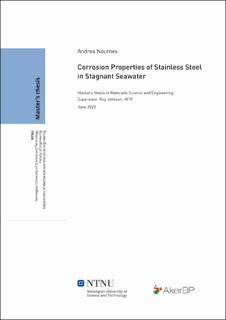| dc.description.abstract | Denne rapporten fokuserer på korrosjonsegenskapene til rustfritt stål i stillestående sjøvann i åpne og lukkede beholdere. I flere tiår har ulike legeringer av rustfritt stål blitt brukt i marint miljø på grunn av korrosjonsmotstanden. Grop- og spaltkorrosjon har imidlertid blitt observert. Undersjøiske rørledninger, spoler, og komponenter er ofte laget av rustfritt stål. Ved installasjoner og igangkjøring kan disse komponentene i en periode bli fylt med stillestående sjøvann - både åpent og lukket for sjøvannet rundt. Hvordan dette påvirker korrosjonsegenskapene til rustfritt stål er en kontinuerlig diskusjon. Denne studien tar sikte på å undersøke korrosjonsegenskapene til utvalgte legeringer av rustfritt stål i åpne og lukkede beholdere ved romtemperatur (22 ± 1°C), og 5 ± 2°C. Karbonstål er også inkludert for sammenligning.
I denne studien ble effekten av tilgang på oksygen undersøkt ved å utføre eksperimenter på rustfritt stål med ulike legeringselementer. Beholdere laget av de ulike legeringen ble utstyrt med bunn- og topplokk av PVC og fylt med naturlig sjøvann. Grop- og spaltprøver av disse legeringene ble også eksponert i de samme beholderne for å undersøke motstand mot grop- og spaltkorrosjon. Måling av åpne krets potensial ble utført på rørveggen, og grop- og spaltprøvene ved romtemperatur og 5 ± 2°C, for åpne og lukkede beholdere. Cyclic potentiodynamic polarization kurver ble gjennomført på grop- og spaltprøver av de ulike legeringene i naturlig sjøvann, med hensyn til temperatur og oksygeninnhold. Etter testene ble alle overflater undersøkt for mulige korrosjonsangrep.
Resultatene fra det eksperimentelle arbeidet viste at rør uten forbindelse til nye kilder av oksygen kan redusere korrosjonshastigheten til de utvalgte rustfritt stål legeringene. Utviklingen av groper i de åpne beholderne, med tilgang til luft, var mer omfattende enn gropene som ble funnet i de lukkede beholderne. Målingene fra åpen krets potensial og cyclic potentiodynamic polarization dokumenterte at 316L, DSS og SDSS viser korrosjonsmotstand under disse forholdene i både åpne og lukkede beholdere. Det ble imidlertid funnet indikasjoner av korrosjonsangrep på disse prøvene etter at åpen krets potensial målingene ble avsluttet. Basert på litteratursøket er 316L følsom for korrosjonsangrep ved disse forholdene på grunn av at den kritiske grop temperaturen er omtrent romtemperatur og den kritiske spalt temperaturen er under romtemperatur. Uten omfattende overflatekarakterisering er det imidlertid ikke mulig å spesifisere om disse indikasjonene er groper eller metastabile groper. Det konkluderes med at 13Cr vil utsettes for korrosjonsangrep i stillestående sjøvann ved romtemperatur i både åpen og lukket beholder. | |
| dc.description.abstract | This thesis focuses on corrosion properties of stainless steel in stagnant seawater in open and closed compartments. Different stainless steel alloys have frequently been used in marine environments for several decades due to the corrosion resistance. However, pitting and crevice corrosion attacks have been observed. Subsea pipelines, spools, and components are often made of stainless steel. During installation and commissioning, these components can be internally filled with stagnant seawater for a period – both open and closed to the surrounding seawater. How this affects the corrosion behavior of stainless steel is a continuous discussion. This study aims to investigate the corrosion behavior of selected stainless steel alloys in open and closed compartments at room temperature (22 ± 1°C), and 5 ± 2°C. Carbon steel is also included in the test program for comparison.
In this study, the effect of access to oxygen on the corrosion properties was investigated by conducting experiments with stainless steels of different alloy compositions. Compartments made from the selected alloys were equipped with bottom and top caps made from PVC and filled with natural seawater. Pit- and crevice-samples of the selected alloys were exposed through the top cap to examine resistance to pitting and crevice corrosion. Open circuit potential measurements were conducted on the pipe wall-, pit-, and crevice-samples at room temperature and 5 ± 2°C, for open and closed compartments. Cyclic potentiodynamic polarization curves were recorded for pit- and crevice-samples of the different alloys in natural seawater, with regard to temperature and oxygen content. After ending the tests, all surfaces were investigated for possible corrosion attacks.
The results from the experimental work show that pipes without new sources of oxygen could reduce the corrosion rate for the selected stainless steel alloys. The growth of pits in the open compartments, with access to air, was more extensive than the pits found in the closed compartments. According to the open circuit potential and cyclic potentiodynamic polarization measurements, 316L, DSS, and SDSS exhibited corrosion resistance in these conditions in both open and closed compartment. However, indications of corrosion attacks were found on these samples after exposure to the long term open circuit potential measurements. Based on the literature survey, 316L is sensitive to corrosion attacks in these conditions due to the critical pitting temperature being about room temperature and the critical crevice temperature being below room temperature. However, without extensive surface characterization, it is not possible to specify if these indications of corrosion attacks were pits or metastable pits. It was concluded that the 13Cr will experience corrosion attacks in stagnant seawater at room temperature in both open and closed compartment. | |
